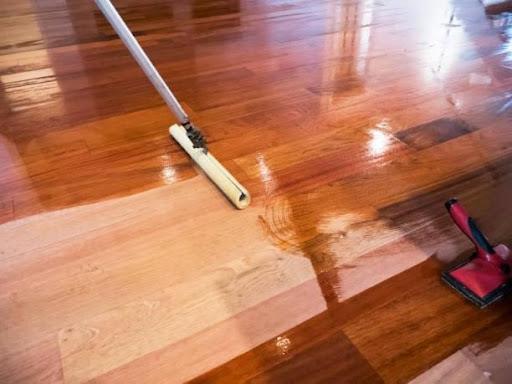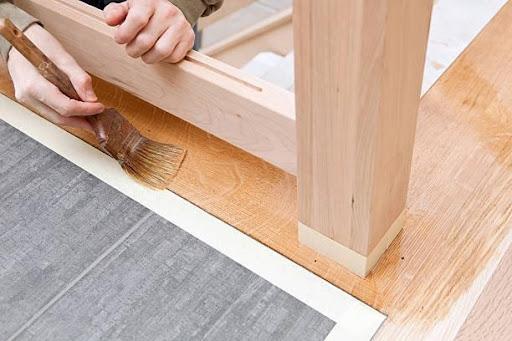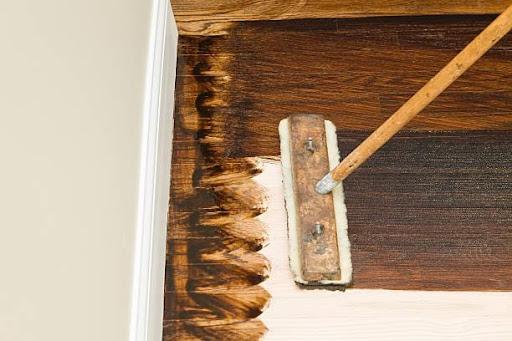Best Way For Hardwood Floor Refinishing
Refinishing a hardwood floor is an excellent method to refresh the look of a space without the hassle and expense of replacing it. Using a big floor sander, the top layer of the covering material is removed. This will help in eliminating the surface polish and digging down beyond any surface scratches, stains, or defects that may exist. As a result, you’ll have a clean surface that you may stain and top-coat with any protective floor finish you like.
Sanding, on the other hand, will not be able to remove really deep scratches, gouges, or stains. Even pros urge homeowners to have realistic expectations about the results of floor sanding.
Floor sanding removes around 1/16 inch of wood at most. Any damage that is deeper than that is usually still visible, but less so. (HGTV, 2020)
ProTip Takeaway. Sanding floors with a hand sander is theoretically doable. It is almost always done with a huge upright drum sander which is an expensive gear that is usually rented rather than owned.
How Much Will It Cost To Sand And Refinish Hardwood Floors?
Refinishing and sanding hardwood floors is a difficult task. If you make a mistake, it will be obvious. A refinished floor, on the other hand, may add beauty to a room like no other renovation.
It will cost $3 to $8 per square foot or more to hire a professional to sand, seal, stain, and apply multiple final coats of oil-based polyurethane. This indicates that refinishing hardwood floors in a 2,000 square foot home will cost roughly $8,000 in labor and supplies.
You can save at least half of the cost by doing it yourself. If you’re searching for a do-it-yourself home remodeling project, this one will take four days and cost around $500 – $700 per 275 square feet.
Sanding and applying two or more layers of surface finish are some of the things done in the professional process. The entire procedure, including cleanup, should take three to five days. (Family Handyman, 2021)
Tools and Materials You’ll Need
|
Tools |
Materials |
|
Pry bar |
Plastic sheeting |
|
Hammer |
Painter’s tape |
|
Under-radiator sander (optional) |
Wood putty |
|
Brad nailer |
Fine-grit sandpaper |
|
Eye, hearing, and breathing protection |
Tack cloths |
|
Upright drum sander |
Topcoat finish (sealer, polyurethane, or varnish) |
|
Paintbrush and roller |
40- or 60-grit sanding pads for the edge sander |
|
Broom |
40- or 60-grit sanding belts for the upright sander |
|
Edge sander |
Wood stain (optional) |
|
Paint scraper Shop vacuum |
Clean cloths |
|
Random orbital sander |
|
|
Shop vacuum |
(Source: The Spruce)
Project Step-By-Step To Hardwood Floor Refinishing
Follow these steps to refinish hardwood floors in a professional manner.
-
Prepare The Room
Remove all of the furniture, window coverings, and carpets from the room. Use painter’s tape to cover vents and electrical boxes to keep dust out of the ducts and electrical work. If you’re only refurbishing one room, plastic sheeting can be used to shut doorways.
Remove the base molding with a pry bar. The small piece of quarter-round can be removed, but the rest of the baseboards can be left in place.
Remove any nails or staples with needle-nosed pliers. Any loose boards should be nailed down. (The Spruce, 2021)
ProTip Takeaway. As you remove the molding pieces, number them with a pencil so you can replace them correctly.
- Repair and Patch the floor
Look for larger holes or cracks in the floor and fix them using wood filler and a spackle knife. If your flooring is severely damaged, a trowel filler, which is a thinner wood filler that spreads and covers vast areas, is the best option. You’ll use a large putty knife to apply it.
Use a wood patch filler in separate locations if your flooring is less damaged. Allow enough time for complete drying of the filling. To remove any debris and dust, wipe the floor with a moist rag. Before sanding, let the floor dry completely.
ProTip Takeaway. As you clean, mark any deep scratches, ridges, or spots where the finish has worn away using pieces of masking tape. You’ll need to pay extra attention to these dangerous regions.
-
Sand the Floor
You will first need to install a 40- or 60-grit sanding belt on an upright drum sander. Sand the entire floor while wearing protective gear (eye, hearing, and breathing). Sand the floor by going parallel to the direction of the boards rather than across the wood grain.
Sand in a series of lengthy passes, 2 to 4 inches between each pass. Get as close to the walls as possible, but don’t let the tool contact the baseboards.
It’s also important to know how to start and stop the sander. When you turn the machine on, make sure the drum sander is raised off the floor, and then lower it as you move ahead with a long forward stroke. Raise the drum before stopping moving the sander when you reach the far wall.
For the edges and corners:
Sand the room’s edges and corners, up to the baseboards, with a hand-held random orbital sander fitted with 40- or 60-grit sandpaper. To remove the remaining bits of finish in corners, you may need to use a paint scraper.
When changing grades on the drum sander, be sure to use the same grade sandpaper on the edger to keep the entire floor sanded at the same consistency. When you’re done sanding, vacuum the area and wipe the sanded parts with a tack cloth to remove any dust. (This Old House, 2021)
ProTip Takeaway. Failure to follow this procedure can result in floor dips and severe damage. You can use a drum sander rented from a home improvement store for this step. When renting the equipment, you can request quick instruction and tips.
-
Buff the Floor
Buffing the floor removes minor sanding marks and leaves it entirely smooth. For this step, some people rent an industrial floor buffer, but a pole sander is also a wonderful alternative. Using a pole sander takes a little longer, but it’s also less expensive and easier to operate than a buffer. Buff the floor with a 120-grit sanding screen along with each board, working back and forth with the grain.
ProTip Takeaway. Place fans in open windows, close ducts, seal off the work area, and wear a dust mask to keep dust away.
-
Apply Wood Stain (If Desired)
The wood can now be stained any color you desire if you like. There are many different wood stains and colors to choose from, but one simple approach is to use a rub-in stain applied with clean cloths. Before applying the topcoat, make sure the stain has dried fully (typically 24 hours).
ProTip Takeaway. Oil-based stains last longer than water-based stains. Do not allow the leading edge of your job to dry as this will result in lap marks (stripes).
-
Apply a Finishing Coat
Although the term varnish is used to refer to any topcoat layer, there are a few options to consider:
A typical sealer: This is a thin, protective liquid that is brushed on top of hardwood, absorbing into the pores and leaving a clear surface layer. It lets the wood’s original color and texture show through. It also gives the least protection depending on the traffic of the space. It may need to be renewed every six to twelve months.
Polyurethane is currently the most used hardwood floor topcoat treatment. Polyurethane is a clear, almost plastic-like substance that can be applied with a regular paintbrush. It also comes in a range of finishes from matte to glossy. It creates a transparent, protective layer that resists stains and scratches over the surface of the wood.
Traditional varnish is similar to polyurethane. The only difference is that it darkens the wood more dramatically than polyurethane. The advantage of this varnish is that it is thinner, allowing for easier spot repairs in the event of future damage.
ProTip Takeaway. Water-based and oil-based formulations of polyurethane coatings are available. Water-based polyurethane is easier to work with and dries faster, but it tends to show flaws.
Oil-based polyurethane is slow-drying and stinky, but it gives the finish a very smooth, exquisite appearance. (Bob Vila, 2021)
-
Have a plan for getting out
Begin your applications along the wall directly opposite the exit door. Working in parallel rows toward the wall with the door is the best way to go.
As you approach closer to the door, you’ll need to shift your work pattern to working from the end walls toward the door. This is because consistent smoothing strokes are difficult to create. Also, add a little extra poly and rely on its self-leveling characteristics for a smooth finish.
-
Replace the moldings if necessary.
The base shoe or other moldings must be installed around the walls to cover the edge of the newly finished flooring. Use a brad nailer, to tack these moldings into place.
Are You Ready to Refinish Your Hardwood Flooring
As you can see, refinishing hardwood flooring takes time and work, but in most cases, the methods are simple. Refinishing hardwood floors on your own may change a room and save you money.
If the thought of refinishing your hardwood floors on your own is too much to bear, get in touch with us and let Smart Remodeling LLC handle it for you! We are one of the leading home remodeling firms in Houston, Texas. Our skilled installers and hardwood refinishers will work hard to guarantee that the finished floor looks brand new. Get in touch with us today for a free consultation.








